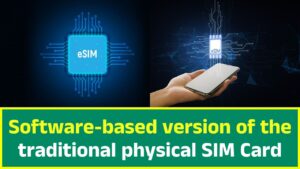Software-based version of the traditional physical SIM Card
eSIM Technology A Comprehensive Overview
Introduction
The eSIM (embedded SIM) is a software-based version of the traditional physical SIM card, revolutionizing mobile connectivity. Built into devices during manufacturing, it eliminates the need for physical SIM trays, enabling remote provisioning and improved flexibility.

What is an eSIM?
An eSIM is a programmable chip integrated into devices that stores carrier profiles. It uses OTA provisioning to download and manage profiles securely, adhering to GSMA standards. Users can activate or switch profiles seamlessly through device settings without needing a physical SIM card.
Key Benefits of eSIMs
- Convenience: No physical SIM swapping; easy profile switching.
- Space-Saving: Eliminates SIM trays, allowing for sleeker device designs.
- Global Roaming: Simplifies access to local networks while traveling.
- Durability: Enhanced device resistance to water and dust.
- Eco-Friendly: Reduces plastic waste and carbon footprint.
Use Cases
eSIMs are utilized across industries:
- Consumer Devices: Smartphones, smartwatches, and tablets.
- IoT: Enables connectivity in smart home devices, wearables, and vehicles.
- Enterprise: Used in fleet management and employee devices.
- Travel: Local carrier access without physical SIM cards.
- Automotive: Connected vehicles with real-time navigation and emergency features.
How eSIMs Work
- Activation: Users scan a QR code or use an app for profile setup.
- Provisioning: Carrier profiles are downloaded using OTA technology.
- Switching: Manage multiple profiles through device settings.
Challenges
- Limited Carrier Support: Not all telecom providers support eSIMs.
- Device Compatibility: Older devices lack eSIM functionality.
- Security Concerns: Ensuring secure OTA provisioning.
- Infrastructure Requirements: Needs advanced carrier systems.
Future Trends
The adoption of eSIMs is expected to accelerate with advancements in 5G, IoT, and global carrier support. The technology will play a critical role in smart cities, autonomous vehicles, and connected industries.
Comparison: eSIM vs. Physical SIM
Conclusion
The eSIM is transforming mobile and IoT connectivity by offering flexibility, durability, and sustainability. It has the potential to become the standard for all connected devices, ensuring seamless communication in an increasingly digital world.
